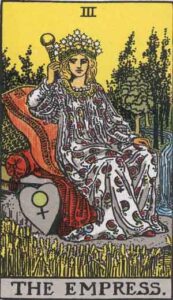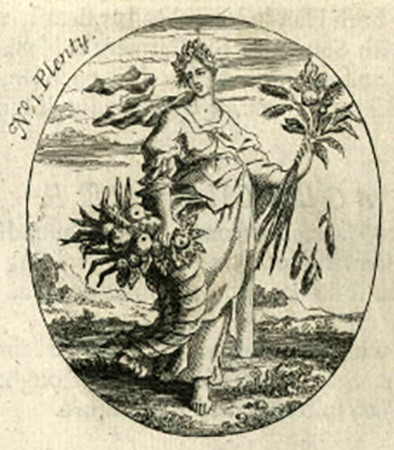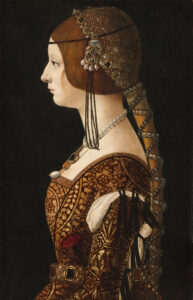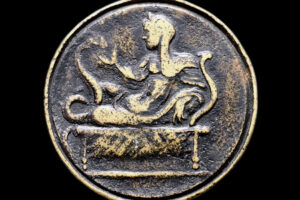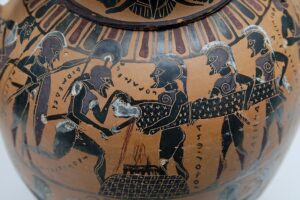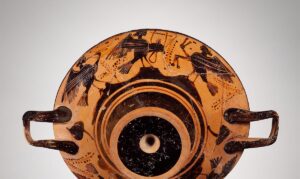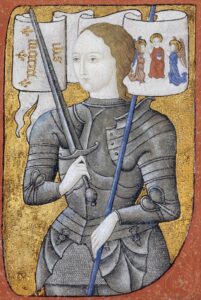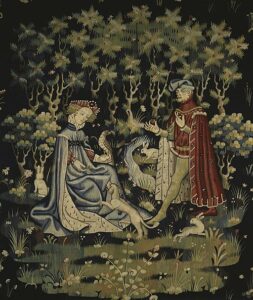
Abstract
Tarocchi, Tarot, empress, queens, iconology, iconography, symbolism, Erwin Panofsky’s three strata theory in Art History, C. G. Jung’s archetypes
Keywords: tarot, queens, esoterica
The mid-fifteenth-century Milanese Visconti-Sforza Tarocchi—the first deck ever created—the end-of-the-fifteenth-century Ferrarese Sola-Busca deck, with scenes for both the Major and Minor Arcana, and the French sixteenth-/seventeenth-century (depending on the view of the scholar) Tarot de Marseilles deck all existed before the Rider-Waite-Smith deck. Visual comparison of the Rider-Waite-Smith Empress and Queens cards to the same cards in these older decks proves a definite continuity in the representation of the subject matter and the use of similar symbols with certain differences.
The royal court, the center of the kingdom, has been the residence and administrative headquarters of monarchies large and small, since time immemorial. The court included the Empress, the Emperor, Queens, Kings, knights, pages, and a household of employees and soldiers. Specialists such as artists, musicians, fools, clockmakers, and poets, too, had a place within the court of the monarch.
The cards are explained according to Erwin Panofsky’s three strata theory in Art History and the symbolism of C. G. Jung. The first Raider-Waite-Smith tarot card discussed in this paper is the Empress.
The Rider-Waite-Smith’s Major Arcana card, The Empress, is a stately seated figure, with rich embroidered vestments in the royal aspect of a daughter of heaven and earth (Waite, 1909). Her flowing white robe has the design of pomegranates sliced open to reveal their red seeds and green stalks. She is in the middle of a lush garden in a natural setting, sitting on an embroidered red velvet couch with a tasseled, bordered pillow. On top of her blonde, longhaired head is a diadem of twelve stars, gathered in a cluster. A field of corn echoing the color of her hair is ripening in front of her dais, and a flowing stream waters the lush garden around her. An orb surmounts the scepter which she bears in her right hand.
On the heart-shaped bouche shield that stands next to her throne is the symbol of the planet and goddess Venus. This astrological symbol portrays a woman touched by the goddess Venus and associated with Ceres, a goddess of vegetation and inspiration (Nichols, 1980). Below is an illustration by Caesare Ripa named Abundance; a concept that the Empress symbolizes.
Her flowery dress and the garden itself represent fecundity; they signify ephemeral beauty and the dualism of life and death. The garden symbolizes bliss, innocence, order, safety, and peace, and is possibly one of the greatest mystical, philosophic, and religious symbols. Since the dawn of history, there have been gardens wherever there was a civilization. From the hanging gardens of Babylonia, to those of ancient Egypt and of Zen, gardens symbolize rest and relief from the heat of the sun by offering shade, water, flowers, animals, and fruit trees.
The ear of corn is considered to be an attribute of the Virgin Mary and of the goddess Demeter (Ceres), whose mysteries at Eleusis were believed to hold the key to immortality. Water falling into a pool is a symbol of the union between male and female, bringing life to parched soil (Cavendish, 1986). Since the Empress’ attribute is the element of water; the river shown on the card has form, function, and a process that enables etiological myths and symbols to arise because all rivers have a source, tributaries, and flow downward to end in a body of water. Their downward movement from beginning to end symbolizes freshness, flow, time, movement, change, transformation, and the endless circle of life and death (Battistini, 2005).
In 1855, Eliphas Lévi changed The Empress’ imperial crown to a stellar one, naming her the woman clothed with the sun and crowned with twelve stars. From the Biblical book of Revelations, she was named Venus-Urania, which was later altered to Isis-Urania by the Christians (Battistini, 2005). The twelve stars on her crown symbolize the twelve signs of the zodiac and point to a deeply rooted solar or zodiacal symbolism (Huson, 2004). Being set on the top of the head makes the crown a sign of overriding significance, because its circular shape is a representation of perfection that combines what is above with what is below. The meaning of the crown derives from that of the head, linked in a strictly emblematic manner, the very idea of pre-eminence (Cirlot, 2001).
Within the aspect of iconology, the cult of the Cosmic Mother appeared at a time in history when humans were not aware of the biological role of men in the creation of the next generation and thought that children were implanted into women by nature’s magic. As Eliade expresses the idea: “…what we would call the ‘divinities of earth’ were really ‘divinities of the place’ in a sense of cosmic surroundings.” (Eliade, 1956). When the true origin of children became clear, motherhood became attached to earth and to the chthonic realms (Wang, 2001).
There were important parameters controlling how women were represented in the material culture of the ancient world. These unofficial, socially defined norms and values varied greatly across time, geographic region, and in accordance with the status of the woman honored. Thus, in Greek and Roman society the portraits of imperial women transcended many of these rhetoric of feminine virtue of parameters in these eras (Art and Women in the Ancient World).
The Empress, supreme archetype of femininity and fertility, is a woman liberated from certain constraints of the church, but not of society. She is the symbol of the eternal mother, considered responsible for the education of her children, while at the same time expressing love and authority. In reality, the Empress was often a frustrated young woman from a high-noble background, who was generally married to a strange old man because of political motivations between royal families, and that was something that the common people could not understand
(“Imperatrix – Empress,” The Tarot Wheel).
The Rider-Waite-Smith Empress card associates the card, for the early-twentieth-century British viewer, with a new dimension of awareness through intuitive understanding. As expected of all British royals, the Empress is shown sitting in a space governed by restrictive and ordering principles such as culture, art, and divine commandment, protected from dangerous snares and untamed nature. Despite modernization, the psychoanalysis of Freud and Jung, scientific progressions, and the Suffragette Movement, Waite maintained that she is “…the inferior Garden of Eden, the Earthly Paradise all that is symbolized by the visible house of man.” (Waite, 1909), demoting her once more in his and the British society’s patriarchal attitude of the early-twentieth-century era.
It is notable to mention that the Visconti-Sforza and the Tarot de Marseilles Empress cards are similar in their depiction, other than some details that were probably the result of the visual expectations of the card players during the specific historical eras of their design. The Visconti-Sforza Empress wears an embroidered golden gown covered with blossoms, often used by Filippo Maria Visconti to indicate his own daughter, Bianca Maria Visconti (“The Empress,” Tarot.com.). The texture of the dress includes the three interlocking diamond rings that are the symbol of the Sforza family, and a crown named Piumai with a green feather, which is transpierced by a palm and olive branch, symbol of the Visconti family. Below is a painting of Empress Bianca Maria Sforza. This painting enables the viewer to see how the Empress was actually represented by the artists of the fifteenth century.
The Tarot de Marseilles Empress wears the colors of the Virgin Mary. This specific Empress card might have originally been influenced by medieval paintings of the coronation of Mary as Queen of Heaven, dressed in royal robes, crowned and throned like a Byzantine empress (Cavendish, 1986). Below is a detail from a mosaic in St. Peter’s Basilica in San Marco, Florence depicting Mary, Queen of Heaven, dressed in her full glory despite never having been a historical Empress but having instead received her elevated status from the Christian religious authorities.
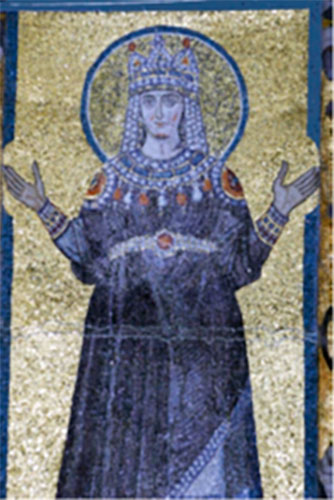
Mary Queen of Heaven, c. 705-707, detail of mosaic from the oratory of John VII that used to be in the funerary chapel of Pope John VII in Old St Peter’s Constantinian Basilica in Rome and after its destruction, was moved to St. Peter’s basilica, San Marco, Florence,
Waite and Smith changed the Empress’s shield from the bouche shields of the Visconti-Sforza and the Tarot de Marseilles Empress cards, with an emblazoned crest of an imperial black/gold eagle (Cody, 2013). Since the female eagle is larger than the male one, the eagle is often a feminine symbol, and in the case of alchemy where the eagle is interchangeable with the phoenix, and a bird, it signifies the spiritualization of instinct (Nichols, 1980). Waite, who was interested in giving his Empress a softer, more feminine, and loving touch, replaced the fearsome eagle on a bouche shield with a heart-shaped shield bearing the symbol of the planet and the goddess Venus.
Moreover, Waite and Smith transformed the golden, jewel-studded crowns of the other Empresses to a stellar diadem of twelve stars, and their rather plain thrones into an embroidered red velvet couch with a tasseled, bordered pillow. They were not interested in deleting but rather in adding or keeping the well-recognized visual symbols.
As a symbol of female perfection, the Empress was usually portrayed on the Tarot cards as a young, beautiful, and distant figure. In medieval Europe, the Empress card represented whatever queen currently ruled the land, probably to satisfy the Inquisitors. In Renaissance Art, the Empress was an irreproachable lady of high family, married to one of the most powerful men in Europe, mother of his heir and head of the imperial family when receiving guests or hosting parties (“Imperatrix – Empress,” The Tarot Wheel). As the horizon of expectation metamorphoses through time, different aspects of the work will come into view for different historical audiences (Holly, 2002).
In terms of iconography, the Empress Tarot card has mostly maintained visual continuity, with symbolic additions, since she was first portrayed in the Visconti-Sforza Tarocchi deck. She is the supreme archetype of female secular authority and political power, on and behind the throne (Huson, 2004). She is the link between the Magician’s fiery yang energy and the High Priestess’s watery yin energy, giving both a body in the world of sensory experience. Her card’s number, three, stands for the reconciliation of opposites that produces a new unity, the union of male and female, which creates the child and heir (Cavendish, 1986).
Jung maintains that the place of magic transformation and rebirth, together with the underworld and its inhabitants, are presided over by the mother. In her destructive aspect, the mother archetype may connote anything secret, hidden, and dark; the abyss, the world of the dead, anything that devours, seduces, and poisons, and that is terrifying and inescapable, like faith (Jung, 1957). As the cosmic mother, she is personified either by the Phoenician Goddess Asherat of the Sea, known as Mother of the Gods or Creator of the Gods, or the Egyptian Goddess Isis. Egyptologist Wallis Budge explained:
Isis was the great and beneficial Goddess and mother whose influence and love prevailed all Heaven and Earth, and the abode of the dead, and she was the personification of the great female, creative power, which conceived, and brought forth every living creature and thing, from the Gods in Heaven, to men on earth (Budge, 1969).
The mother archetype is essential to the process of self-realization, especially for a man, because she is the extension of the qualities of the anima. Consequently, the insights into the mysteries of the mother archetype hide, historically, in the most cryptic language of both iconography and iconology. As the representation of the anima, she is symbolically associated with both the elements of earth and water, portrayed as timeless and wise. According to Jung, her knowledge is an ancient, enigmatic, and intuitive wisdom, whose true function in the mind is creativity (Jung, 1957).
Is the Empress, behind her serene and regal portrayal in the various Tarot decks, a witch or a goddess, a devouring mother or a Madonna, a noble young woman married off against her wishes or a wise woman who pulls the strings behind the throne, a femme fatale or a femme inspiratrice (Nichols, 1980)? There is no simple answer to this query. The Empress card probably encapsulates all these iconographic and iconological attributes. Artistically, according to how the illustrators wanted to portray her within the boundaries of their art; symbolically, by the particular attributes used to represent certain figures during a specific time in history; and in terms of iconology by the point of view and expectations of the spectators, for whom the cards were designed.
As opposed to their depiction in the Tarot decks, queens were represented in Renaissance art as nursing an infant, immersed in nature, or surrounded by attributes that allude to fertility.
The next card discussed is the Rider-Waite-Smith Queen of Wands.
The Rider-Waite-Smith Queen of Wands
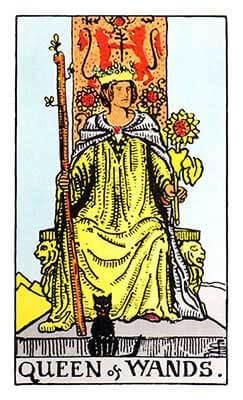
The Rider-Waite-Smith Minor Arcana Queen of Wands sits on an elaborate stone throne. Most of the background of the card is the clear blue sky, while the throne is situated in an arid landscape reminiscent of sand dunes. The high back of her orange throne has decorations of red heraldic lions wearing crowns, and there are statues of lions on either side as armrests. She holds a blossoming wand in her right hand, a sunflower scepter in her left hand, and her black feline companion is the domestic representative of the lion. Her crown, shaped like tongues of flames, symbolizes the element of fire attributed to this suit.
In terms of iconography, the sunflower symbolizes loyalty, optimism, long life, endurance, and the strength to persevere through the hardest moments. Since the name sunflower (helianthus) originated from the Greek words helios (sun) and anthos (flower), the ancient Greeks devoted the sunflower to the god of the sun, Helios (“Sunflower – Meaning, Symbolism and Colors,” Flower Meanings).
The Ancient Egyptians had a great reverence for cats and associated them with the goddesses Bast (Bastet) and Sekhmet, as did the Celts with the goddess Brigid. Cats of any colour are strongly associated with magic. Thus, Druidic priests would use cat magic to cross between the spiritual and physical worlds because they are symbolic of rebirth and resurrection, per their nine lives (Wigington, “Black Cats,” Learn Religions). The symbolism of the black cat has undergone several upheavals according to historical timeframe and geography. On the one hand, fifteenth-century Italians believed that if a black cat jumped on the bed of an ill person, the person would soon die, while on the other hand, in England’s border countries and southern Scotland, a strange black cat on the front porch brings good fortune (Wigington, “Black Cats,” Learn Religions). Consequently, Waite and Smith, who were involved in esoteric practices, placed the black cat perched on the platform of the throne. According to Jung, the animal stands for the non-human psyche, the world of subhuman instincts, and the unconscious areas of the psyche (Cirlot, 2001).
The heraldic lion, with the repute of its noble nature, and position and title of king of beasts, is one of the most common symbols on the continent of Europe. It has been favoured by many royal houses as it symbolizes bravery, ferocity, strength, movement, and valour. Moreover, like the sunflower, it is also associated with the sun and the element of fire, as is the suit of wands.
Earlier designs of the Tarot Queen of Wands, in terms of iconology, are either related to historical or mythical figures. The Sola-Busca Queen of Wands’ name is Palas, referred to as the goddess Pallas Athena, one of three virgin goddesses who was the guardian of the city of Athens. As to the Tarot de Marseilles Queen of Wands, according to Huson, in very early times her favorite name was Penthesilea, who was a queen of the Amazons in Greek mythology and respected for her bravery, skill in weapons, and wisdom. Rachel, wife of Jacob from the Old Testament, later eclipsed Penthesilea’s popularity and became the persona to whom the card referred (Huson, 2004).
In conclusion, while visually comparing the Rider-Waite-Smith Queen of Wands card with earlier Queen of Wands cards, it is evident that there is a definite continuity in the depiction of the subject matter. Waite and Smith embellished their card with additional symbols related to the element of fire.
The next card discussed within this article is the Rider-Waite-Smith Minor Arcana Queen of Cups.
The Rider-Waite-Smith Queen of Cups
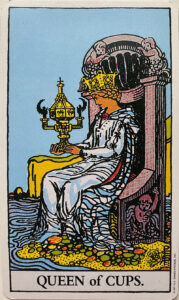 The Rider-Waite-Smith Minor Arcana Queen of Cups sits on a large stone throne by the calm ocean’s edge on a bright sunny day, her gaze concentrating on the cup. She holds the cup, which is the symbol of her suit, with both her hands rather than holding it between the stem and the bowl, like all the cups save for the Ace are held within the suit. The cup she holds is elaborate, and unique in the suit of cups in which no other cup variates on the design so strongly, as it has a lid with two claw-like black handles, a cross at the top, and looks more like an urn than a cup.
The Rider-Waite-Smith Minor Arcana Queen of Cups sits on a large stone throne by the calm ocean’s edge on a bright sunny day, her gaze concentrating on the cup. She holds the cup, which is the symbol of her suit, with both her hands rather than holding it between the stem and the bowl, like all the cups save for the Ace are held within the suit. The cup she holds is elaborate, and unique in the suit of cups in which no other cup variates on the design so strongly, as it has a lid with two claw-like black handles, a cross at the top, and looks more like an urn than a cup.
She rests her blue shoe on the edge of the water where there are colorful pebbles and seashells. Two mer-children (undines) who are the elemental spirits of water support the scallop-carved top of her throne on which they are perched, while the third one, on the left side of the throne with a fish in his hand, is probably trying to climb up too. In terms of iconography, the ocean—as opposed to the concept of the drop of water—is a symbol of universal life since it is traditionally and scientifically regarded as the source of all life (Cirlot, 2001). The seashells are one of the eight emblems of good luck in Chinese Buddhism, found in allegories about royalty, and a sign for a prosperous journey, since they are associated with water, the source of fertility. According to Eliade, shells are linked to the moon and to women, because they were closely connected to the concept of the goddess in pre-monotheistic eras (Eliade, 2019).
In terms of iconology, the Queen of Cups rules the emotional realm, and the element of water is typically symbolic of the unconscious and feeling. Her lonely position at the shore indicates that she lies in liminal space between land and sea, the expanse where feeling and thought exist, enabling her to feel and think serenely. The cup is a symbol of the goddess’s cauldron in many myths and legends, including those about King Arthur. Thus, the Queen of Cups might represent the Grail Queen as well as the goddess of family. The waters, the moon and the woman are all associated with each other because the waters, although deep and chaotic, give rise to life, as do women, and are similarly ruled by the cycles of the moon (Mouw, 2018). The ocean is equated with the collective unconscious, out of which arises the sun of the spirit. The stormy sea, as a poetic image or a dream, is a sign of an analogous state in the lower depths of the affective unconscious while a translucent calm, on the other hand, denotes a state of contemplative serenity (Cirlot, 2001). According to Jung:
…water is the commonest symbol for the unconscious. The lake in the valley is the unconscious, which lies, as it were, underneath consciousness, so that it is often referred to as the “subconscious,” usually with the pejorative connotation of an inferior consciousness. Water is the “valley spirit,” the water dragon of Tao, whose nature resembles water – a yang in the yin… (Jung, 1957).
In reference to the well-known myth of the birth of the goddess Aphrodite, Waite and Smith included the motif of the shell to enhance the mystical properties of prosperity, and the rising of the next generation from the preceding one, out of the primordial waters.
Smith received her inspiration from the depiction of the cup of the Visconti-Sforza Queen of Cups and changed it slightly to suit her needs. Within the aspect of iconology, the Sola-Busca Queen of Cups’ name is Polisena. According to Adams, Polyxena is the original name of Queen Olympia, mother of Alexander the Great (Adams, 2017). In some accounts of the myth, Alexander is the child of Polisena and the dragon-serpent Ammon, God of all Libya in disguise.
Polisena’s dolphin-throne concept changed to the throne by the sea in the Rider-Waite-Smith deck Queen of Cups card, keeping the representation related to the element of water. Below is an example of a contorniate depicting Polisena sitting on a serpent- and dolphin-themed couch.
[place POLISENA illustration here]
Despite Adam’s association of the Sola-Busca Queen of Cups Tarocchi card with the Alexandrian theme, he maintains that if one accepts the polysemy implicit throughout the deck, the same card may have more than one referent. Thus Polisena can also be identified with the Trojan Polyxena (Adams, 2017). Below is an Attic black-figure Tyrrhenian amphora depicting the sacrifice of Polyxena by the triumphant Greeks.
In the case of the Tarot de Marseilles Queen of Cups, the recurring phenomena of some of the queens’ cups being closed instead of open is worth mentioning, since closed cups represent the unknown. In France, the Queen of Cups’ most popular version was the Old Testament Apocrypha heroine Judith, who seduced and then beheaded Nebuchadnezzar’s general Holofernes while he was asleep, causing the besieging Assyrian army to flee the city of Bethulia (Huson, 2004). As Arthurian Romance was renowned during the Middle Ages and in France, the Queen of Cups also represents the Grail Queen. Moreover, Jung maintains that the cup relates in some way to both the Eucharistic Chalice and the vessel used in divination. As a symbol of vigor and strength it has a masculine character and, through its shape, a feminine one. Thus, the cup becomes a uniting symbol, expressing the bipolarity of the archetype (Abstracts of the Collected Works of C. G. Jung, 1992).
In conclusion, while comparing the Rider-Waite-Smith Queen of Cups card to her representation in older decks, there is a visual connection in the depiction of the subject matter and the use of similar symbols. Waite and Smith preserved the previous tradition that alluded to mythical figures. As an ancient vessel used for scrying and divination, the cup is reminiscent of the cauldron used for producing many magical potions. The design of the Tarot Cup evolved from the mythical cauldron of the Goddess found in Avalon, where Morgan le Fay resided, to the legendary Grail and finally to the Tarot cup with its multifaceted meanings.
This, as folklorists would explain, is a process of oicotypification in which a folktale, a symbol, or the motif of a design evolves to suit the needs of a new environment and is absorbed within it. C. W. von Sydow, who formulated his theory of oicotypes, maintained that the process of oicotypification consists of a certain unification of the variants within one and the same linguistic or cultural area on account of isolation from other areas. (Bradunas, 1975) The next card discussed in this chapter is the Rider-Waite-Smith Minor Arcana Queen of Swords.
The Rider-Waite-Smith Queen of Swords
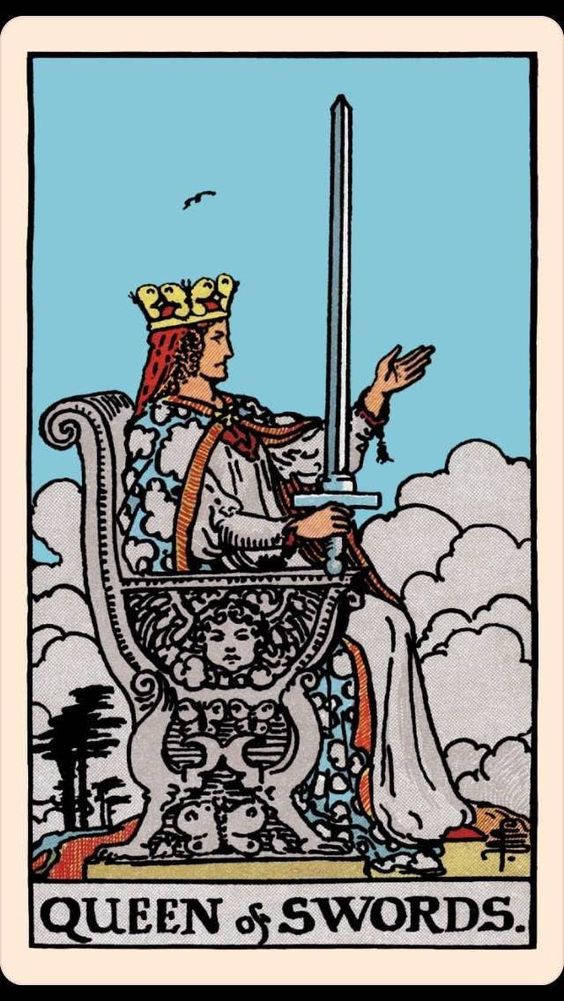 The Rider-Waite-Smith Minor Arcana Queen of Swords sits on her ornate stone throne decorated with representations of a cherub with foliage around his head, and a butterfly. The upper part of the background of the card is light blue, the color of the sky, and includes a bird flying overhead. From her waist downwards, in the background, is an accumulation of many pristine white clouds that gradually turn into stormy grey ones only at the bottom left of the card. The bottom right section of the card portrays pastures, a flowing brook and trees blowing in the strong wind.
The Rider-Waite-Smith Minor Arcana Queen of Swords sits on her ornate stone throne decorated with representations of a cherub with foliage around his head, and a butterfly. The upper part of the background of the card is light blue, the color of the sky, and includes a bird flying overhead. From her waist downwards, in the background, is an accumulation of many pristine white clouds that gradually turn into stormy grey ones only at the bottom left of the card. The bottom right section of the card portrays pastures, a flowing brook and trees blowing in the strong wind.
The straight back of her stone throne’s top culminates in an ionic style. Her left hand extends upwards in offering, while her right hand rests on the armrest of her throne, holding the sword that is the symbol of her suit, vertically pointed towards the sky.
The sword, representation of the suit, is a multifaceted symbol. The sword pip cards represent the element of air, the freedom and clarity of the mind that puts thoughts into action. In alchemy, the sword is a symbol for purifying fire and the transcendent toughness of the all-conquering spirit; a particularly common symbol during the Middle Ages (Cirlot, 2001).
As symbols of the element of air, clouds serve as symbolic and literal veils that separate what is above from what is below. Different types of clouds bring rain, hail, and snow to fertilize the land, and water, condensed in clouds, returns to earth in the form of life-giving rain invested with twofold virtues: it is water, and it comes from heaven (Cirlot, 2001). However, because of their dual symbolism, clouds can also be harbingers of doom, disaster, gloom, obscurity, and dysfunction. The darker clouds at the bottom left of the card might reflect upon her sorrows, while the whiter clouds symbolize the clarity of her mind and thoughts. The accumulation of the clouds, and the strong wind that passes through the trees, symbolize the ongoing nature of change.
The Cherub, in Jewish, Christian, and Islamic literature, is a celestial winged being with human, animal, or birdlike characteristics who functions as a throne bearer of the Deity. Derived from ancient Middle Eastern mythology and iconography, these celestial beings serve important liturgical and intercessory functions in the hierarchy of angels (Amberstone, 2008). The cherubim, which stood at the entrance to Assyrian temples and palaces, were gigantic statues placed there by the priests as keepers of the threshold, a function fulfilled in China by griffins and dragons (Rivière, 1950). The Egyptian cherub, emblem of the night sky, vigilance, and religion, was a figure with many wings, and covered with eyes.
The butterfly is an archetype of metamorphosis, the profoundest sort of physical change, and the inescapable symbol of resurrection. The worm-like caterpillar transforms in its inactive cocoon stage and emerges as a gossamer creature of the air, and this is the main reason butterflies, within the framework of psychoanalysis, are regarded as a symbol of rebirth (Joslyn, “Butterfly and Mythology”). Birds too, may symbolize human souls; one finds some of the earliest examples in in the art of ancient Egypt. Like angels, they are symbols of thought, imagination, and the swiftness of spiritual processes and relationships. Sometimes birds have human heads, as in Hellenic iconography. Below is a detail from a fifth-century Greek drinking cup portraying birds with human heads.
In terms of iconology, Waite and Smith combined ancient and contemporary symbols, themes, myths, legends of prophets, cherubs, butterflies, birds, and swords that belong to the element of air. Visually, and from a standpoint of iconology, they complement each other because of the close links in depicting nature and religious scenes. It is significant to stress that according to Waite, the Queen of Swords is her sword notwithstanding; she is scarcely a symbol of power (Waite, 1909).
For the purpose of comparison, and as concerns the evolvement and iconology of the Raider-Waite-Smith Queen of Swords Tarot card, all the earlier Queens of Swords hold their swords in their right hands. The Sola-Busca Queen of Swords, named Olinpia, sits on her green, hydra-shaped throne with nine green heads and the extra protruding white one (Adams, 2017). According to Hesiod’s Theogony the hydra, also named the Lernean Hydra, was the offspring of Typhon, a grisly monster with a hundred dragons’ heads, and Echidna, who was half woman and half serpent (“Hydra” Greek Mythology). This particular portrayal on the card’s design was probably because of some of the myths told about Olympia (Adams, 2017). Huson maintains that the Tarot de Marseilles Queen of Swords’ name was Pallas as early as the beginning of the sixteenth century, if not earlier (Huson, 2004). In both Greek and Roman mythology Athena/Minerva, who came out of Zeus/Jupiter’s head dressed in full armor, was a virgin goddess of many characteristics including wisdom and war (Huson, 2004). Below is a picture of a detail from a black-figured amphora.
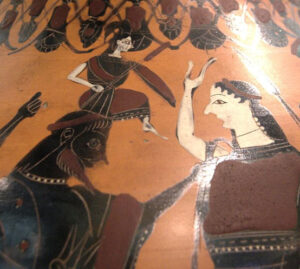
Divine Birth of Athena in full armour, from her Father’s the God Zeus, Louvre Museum, Fould Collection, Musée du Louvre, Atlas database: entry 5877, Public Domain,
It seems that since Pallas/Athena was a maiden, poets referred to her as la Pucelle – the maiden — a name later given to Joan of Arc, whom the Queen of Swords represents (Huson, 2004). Below is a miniature of Joan of Arc wearing armor and holding her sword in her right hand while leaning it on her shoulder.
In conclusion, visually comparing the Rider-Waite-Smith Queen of Swords card to the same card in older decks shows a definite continuity in the representation of the subject matter, and the use of similar symbols. The reason the Queens of Swords of the Tarocchi/Tarot, in all their configurations, hold such sizable swords in their hands is a challenging question to answer. While it is logical to assume that most queens represented in the decks did not fight in wars that plagued the different city-states in Italy and France during the fifteenth and sixteenth centuries, they were still portrayed with the symbols of sovereignty.
While Waite maintains that the Queen of Swords is not a warrior and neither does the Visconti-Sforza depiction seem to be, Olympia/Athena and Joan of Arc were warriors, each in her on particular field. The next card discussed in this chapter is the Raider-Waite-Smith Minor Arcana Queen of Pentacles.
The Rider-Waite-Smith Queen of Pentacles
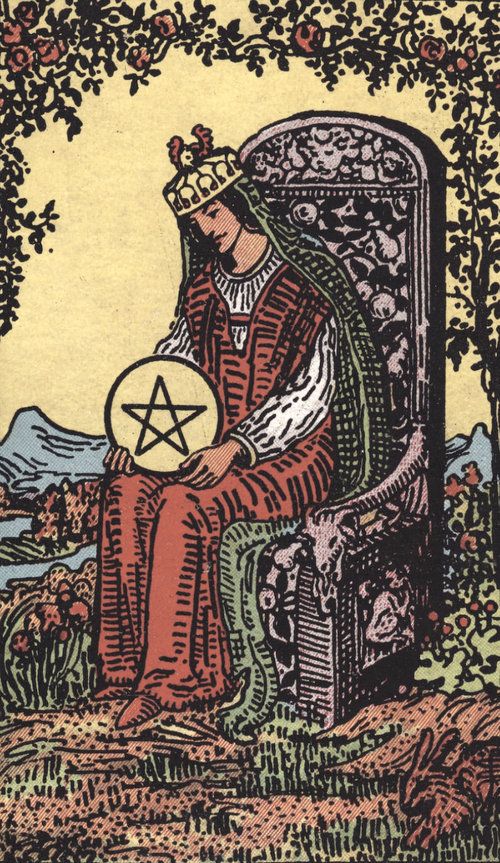 The Rider-Waite-Smith Minor Arcana Queen of Pentacles card depicts a woman holding a large golden coin on her lap, with both hands. The coin has the sign of the pentagram on it. Surrounding her are snow-topped mountains, flowing rivers, a rabbit, blossoming trees, an arbor of lush roses, and green floral gardens with tulips and grass, all quite similar to the Raider-Waite-Smith Empress card.
The Rider-Waite-Smith Minor Arcana Queen of Pentacles card depicts a woman holding a large golden coin on her lap, with both hands. The coin has the sign of the pentagram on it. Surrounding her are snow-topped mountains, flowing rivers, a rabbit, blossoming trees, an arbor of lush roses, and green floral gardens with tulips and grass, all quite similar to the Raider-Waite-Smith Empress card.
The decorations of her stone throne include motifs of fruits, a variety of beasts of the earth, bones, a goat’s head—acknowledging the sign of Capricorn—and a bull’s head implying her bountiful nature, since the Pentacles, the symbol of her suit, are associated with the element of earth.
The roses symbolize the microcosm, the heat of passion, rebirth and immortality, involvement, and consummate achievement (Amberstone, 2004). The red rose is the emblem of Rosalina of Villeneuve, Saint Acisclus, Our Lady of Sorrows, and Saint Hermenegild, while the tulip symbolizes wealth, prosperity, commerce, and trade (“The Rose – Obscure Symbolic Meaning of Flowers in Western Art History”). The Tulip is a symbol of charity for the Victorians, while for the Turkish it is a symbol of paradise on earth and eternal life. The Dutch, who popularized the flower, consider it a reminder of how brief life can be (“The Tulip Flower, Its Meanings and Symbolism”). According to A. Graham-Dixon:
…in the secular paintings of the Renaissance that the most interesting collisions between Christian and older forms of pagan flower symbolism occur. The Christian notion of the flower as a symbol of chastity is challenged by the Greco-Roman (and doubtless older) conception of flowers as emblems of spring, new life, regeneration and the impulse to procreation embodied in classical mythology by the close association of the goddesses of flowers and love, Flora and Venus… (Graham-Dixon, “Art / Say it with Flowers: Andrew Graham-Dixon views Flora Photographica’ and Reflects on the Continuing Fertility of the Floral Image”).
The various skeletal beasts on her throne symbolize her connection to earth through all the fertility of flora, fauna, and fecund growth. The goat’s head on the upper part of the back of her throne represents the sign of Capricorn. The bulls’ heads on the tips of the armrests of her throne are a highly complex symbol, having various meanings in different cultures. As a result, there is a dilemma about which of two opposing symbolic principles to associate with the bull. Depending on the culture he is either associated with the lunar principle, the earth, and the mother goddess, or he is a solar deity that is related to heaven and the father. Mithraic ritual seems to have viewed the bull as a male solar and fire deity expressive of the penetration of the humid feminine principle by the masculine to create fecundity on earth. The lunar bull became a solar bull when the solar cults supplanted the more ancient cult of the moon. There is a possibility that the bull is first and foremost a lunar symbol because it is equated with the moon morphologically by virtue of the resemblance of the horns to the crescent moon, and it must take second place, as a solar symbol, to the lion (Cirlot, 2001). Since, the bull is the most common tame animal in the Near East, this ancient paradox relates to the fact that bulls symbolize lunar as well as solar attributes. Sin was a Mesopotamian lunar god who often took the form of a bull, while Osiris was a lunar god represented by the bull Apis. The Vedic god Sûrya was a solar bull and, according to the Assyrians, the bull was born from the sun (Cirlot, 2001).
The rabbit at the bottom right of the card represents the mother goddess, the Greek goddess Hera, the European goddess Eostre from which the word Easter is derived, the German goddess Erda, and the Mesopotamian goddess Ishtar (Waite, 1909). The rabbit is timid and feral at the same time, and it is a symbol of fecundity, since it proliferates speedily in large amounts, and therefore represents the desires of the flesh and sensuality (Battistini, 2005). The rabbit too is associated with myths from different cultures. In the Native American tradition, the rabbit is a trickster that shows up in various legends like the one of Manabozho, the Great Hare that created the world and humanity. According to the Chinese, rabbits are artistic, delicate, calm, kind, and hard to ignore, because of their connection to the moon, and are a symbol of good luck. The Africans have a legendary rabbit figure by the name of Kalulu, while the Aztecs have rabbit gods associated with drunkenness and fertility. Below is a tapestry from the early fifteenth century depicting a couple enjoying nature while surrounded by a multitude of rabbits. The artist is unknown but was either from the town of Arras in Flanders or a Parisian workshop.
In terms of iconology, the Rider-Waite-Smith Queen of Pentacles is a culmination of the visual and symbolic meanings of the element of earth accumulated throughout the millennia. Everything vegetal, and especially the frequently used symbol of the tree, reveals the image of the seed and of subliminal life in its blossoming and cyclical mystery. It is visibly linked to dynamic, elemental exchanges, and to the mysterious anamorphoses of nature (Stegman, Coursodon and Miller, “Richness and Ambivalence of the Symbol in the Renaissance”). The summit of symbolic perfection lies in the Renaissance art of the garden, revealing the most subtle relationships between overall arrangement, geometric form, and symbolic detail (floral or animal).
When comparing the Rider-Waite-Smith Queen of Pentacles to the Empress of the same deck, it can be hard for the viewer to determine which of the queens is wealthier, or in a better situation, because both are richly dressed, sitting in bountiful gardens with plenty of sun and water, and with no wind to disturb their domain. From an observer’s point of view, it is not clear if the card’s intention is to convey a moral theme that communicates the triviality of riches.
For the purpose of iconological comparison as concerns the evolvement of the Raider-Waite-Smith Queen of Pentacles Tarot card it is significant to mention that the designs of the pentacles differ in the earlier versions. While the Rider-Waite-Smith queen has a pentacle, the Visconti-Sforza queen holds a ducal coin with a family crest, the Sola-Busca queen a blue disk within a golden one, and the Tarot de Marseilles denier’s structure is the most intricate.
From a historical point of view, the Visconti-Sforza Queen of Coins is part of the royal Visconti-Sforza family and was traditionally illustrated as the Sibyl or Oracle (“Queen of Coins,” Tarot.com). The Sola-Busca Queen of Disks, Elena, is a reference to the fateful future of the legendary Helen of Troy, wife of King Menelaus, whose elopement with/kidnapping by Paris, son of the Trojan King Priam, lead to the Trojan War (Adams, 2017). The Tarot de Marseilles Queen of Deniers was associated with a number of real historical queens like Mary of Anjou, the wife of the French King Charles VII, Marie de Medici, wife of King Henry IV, and Argia, daughter of Adrastus, an ancient king of Argos in Greece. She is also linked with literary and legendary queens including Argia Queen of the Fays, and Agrante Queen of Avalon, who seems to be an alter ego of Morgan le Fay and the Grail Queen. The Rider-Waite-Smith Queen of Pentacles, associated with the legendary Grail Queen, includes most of these iconographical analyses and iconological interpretations, according to Erwin Panofsky’s method of investigation of art works.
In conclusion, the artistic and symbolic progression of the Raider-Waite-Smith Queen of Pentacles, from the Visconti-Sforza deck to Raider-Waite-Smith deck, is fascinating, especially from a historical and literary point of view. The definition of the symbol and name of the cards have changed. The depiction of how they hold the pentacle (coin/disk/denier) is different from queen to queen. These differences might cause the viewer to have different reactions, both to the queens and to the symbol of their suit. Since it is impossible to know the reason why each artist decided to depict her in such a fashion, any answers can be no more than speculation.
The Raider-Waite-Smith Queen of Pentacles, with all the symbols depicted on her card, evolves full circle to include all the elements of the previous Queens of Coins/Disks/Deniers, and includes most of these iconographical interpretations and iconological analyses in a most convincing visual composition. The rest of the queens do also symbolize stability, fecundity, and the element of earth.
This research elucidated the pre-iconographical description, iconography, and iconology found in the Rider-Waite-Smith Tarot deck created by the occultist Arthur Edward Waite and illustrated by the artist Pamela Colman-Smith at the beginning of the twentieth century (1909-1910) in England. The in-depth analysis performed was according to Erwin Panofsky’s three strata theory of Art History and Carl Gustav Jung’s Folkloristic Psychological School theory.
Throughout five hundred years the Italian Tarocchi cards, used for parlor games during the early fifteenth century, evolved into esoteric decks by the late eighteenth century (1781) when Count de Gebelin gave them the first occult interpretation. The early versions of the Tarocchi decks, and the Tarot de Marseilles deck, are the foundation of all modern Tarot decks, including the influential Rider-Waite-Smith deck (Place, 2005). Despite having fashioned an occult Tarot deck in the beginning of the twentieth century, Waite and Smith did not solely use the attributes of a Renaissance design per-se. They included some of the visual representations of the early twentieth-century period and influences of the Egyptomania, romantic, and rustic styles of that era as well. Their approach to the design of the deck is an amalgamation of various styles and techniques similar to those used in the Neoclassical, seventeenth century, and the Renaissance periods based on early Greek and Roman art.
Waite and Smith kept the attributes of the basic imagery, motifs, and symbols of the various initial Tarocchi and older versions of Tarot cards by adding their own brand of interpretation and creative design. The decision to relate some of the Rider-Waite-Smith Tarot to three older Tarocchi/Tarot decks was born out of the specific milestones of the iconology and iconography of the decks. Waite and Smith had a plethora of Tarot decks, enabling them to visually create their own deck by including additional images they thought relevant to the scenes on the cards. Over time, further symbols and meanings developed according to art, literature, theater, and psychology, and they also deleted a few icons, as they did not coincide with their specific spiritual goals.
There are some visual style contradictions throughout the deck as, on the one hand, the work is technically complex with thin black outlines around every single object on the card, repetitive intricate shapes, flora, Renaissance towns, and a modern city. On the other hand, the drawings seem to be naïve and uncomplicated if one is to compare them to the original Italian Tarocchi decks.
Folk Art is the traditional decorative or utilitarian art of the people that is often an expression of community life, devoid of a specific creator, and is distinguished from academic, self-conscious, or cosmopolitan expression (“Definition of Folk Art,” Merriam Webster). Although the visual scenes on the decks were not considered as high art—despite the detailed attention given, mainly in the Italian Tarocchi decks—they can definitely be included within the bounds of the popular material culture of Europe. Pamela Colman-Smith’s signature at the bottom left corner might as well remove the Rider-Waite-Smith deck from the specification of folk art, defined as having no designer. Though this premise is debatable in the case of the Rider-Waite-Smith deck, one should remember that the Tarocchi decks existed for almost five hundred years before Pamela Colman-Smith redesigned them based on previous decks, despite having been fashioned for occult purposes.
References
Abstracts of the collected works of C. G. Jung. (1992). (ed.) C. D. Rothgeb, Karnac Books: London
Adams P. M. (2017). The game of Saturn decoding the Sola-Busca tarocchi. Scarlet Imprint, under the Bibliotheque Rouge banner Amberstone R. A. & W. (2008). The secret language of the Tarot. San Francisco: Weiser Books
Battistini M., (2005). Symbols and allegories in art. (trans.) Stephen Sartarelli, Los Angeles: The J. Paul Getty Museum Publications
Bradunas E., (2009). “If You Kill a Snake the Sun Will Cry – Folktale Type 425-M A Study in Oicotype and Folk Belief,” LITUANUS – Lithuanian Quarterly Journal of Arts and Sciences, Volume 21, No.1 – Spring 1975, 1965. accessed: July, 2009. Retrieved from: http://www.lituanus.org/1975/75_1_01.htm And in: “Folktale Studies and Philology: Some points of View” von Sydow. (1948). and in: The Study of Folklore, (ed.) A. Dundee. (1965). Prentice Hall, N. J.
Cavendish R. (1986). The Tarot, London: Chancellor Press
Cirlot J. E. (2001). Dictionary of symbols. (trans.) Routledge & Kegan Paul Ltd., the Taylor & Francis e-Library
Cody J. E. (2013). Birthing eternity: a different perspective on the four horsemen of revelation. Bloomington, IN: West Bow Press – A Division of Thomas Nelson
Eliade M. (2019). The sacred and the profane: nature religion. accessed May 2019. Retrieved from: https://www.goodreads.com/quotes/167288-it-was-lunar-symbolism-that-enabled-man-to-relate
Holly M. A. (2002). “Reciprocity and reception theory,” A companion to art theory. (eds.) P. Smith and C. Wilde. Oxford U.K: Blackwell Publishers Ltd.
Graham-Dixon A. “Art / say it with flowers: Andrew Graham-Dixon views flora photographica and reflects on the continuing fertility of the floral image.” Independent, accessed June 2019. Retrieved from: https://www.independent.co.uk/arts-entertainment/art-say-it-with-flowers-andrew-graham-dixon-views-flora-photographica-and-reflects-on-the-continuing-1548648.html
Holly M. A. (2002). “Reciprocity and reception theory.” A companion to art theory. (eds.) P. Smith and C. Wilde. Oxford U.K: Blackwell Publishers Ltd.
Huson P. (2004). Mystical origins of the Tarot – from ancient roots to modern usage. Vermont: Destiny Books
Joslyn C. “Butterfly and mythology,” Interconnectivity: animals mourning together in modern stories and mythology. accessed: May 2019. Retrieved from: http://scalar.usc.edu/works/chid490animalmourning/index
Jung C. G. (1957). “Archetypes and the collective unconscious,” The collective works of C. G. Jung, Vo. 9, Part 1. New York: Pantheon Books
Mouw E. (May 10, 2018). “Mircea Eliade’s images and symbols: an introduction to the themes.” accessed May 2019. Retrieved from: https://www.furorteutonicus.eu/wp-content/uploads/2018/05/Mircea-Eliade-Images-and-Symbols.pdf
Nichols S. (1980). Jung and Tarot an archetypal journey. York Beach Maine: Samuel Weiser Inc.
Place R. (2005). The Tarot: history, symbolism, and divination. New York: Penguin Publishing Group, Kindle Edition
Riviere M. J. (1950). Amulettes talismans et pantacles. Paris. In Cirlot J. E. (2001). Dictionary of symbols. (trans.) Routledge & Kegan Paul Ltd., the Taylor & Francis e-Library Stegman A., Coursodon J. P. and Miller E. (1972). “Richness and ambivalence of the symbol in the Renaissance,” Yale French studies, No. 47. Image and symbol in the Renaissance. Yale University Press. Retrieved from: Jstor, Stable URL: http://www.jstor.org/stable/2929397
Waite A. E. The pictorial key to the Tarot – being fragments of a secret tradition under the veil of divination. (1909). Retrieved from: http://www.sacred-texts.com/tarot/pktintr.htm.
Wallis Budge E. A. (1969). The Gods of the Egyptians, vol. 2. New York: Dover Publications Inc.
Wang R. (2007). Tarot psychology. Canada: Marcus Aurelius Press
Wigington P. (May 25, 2019). “Black cats.” Learn religions, accessed: June 2019. Retrieved from: learnreligions.com/symbol-black-cats-2562705, and http://www.pure-spirit.com/more-animal-symbolism/226-pure-spirit-minneapolis-st-paul-dog-training-and-international-all-species-animal-communication-cat
“Art and women in the ancient world.” Retrieved from: https://warwick.ac.uk › arts › postgrads › modules
“Definition of folk art.” Merriam Webster. accessed May 2020. Retrieved from: https://www.merriam-webster.com/dictionary/folk%20art
“Hydra.” Greek mythology. Encyclopedia Britannica. accessed: May 2019. Retrieved from: https://www.britannica.com/topic/Hydra-Greek-mythology/media/1/278114/183011
“Imperatrix – empress.” The Tarot wheel. accessed Jan. 2019. Retrieved from: http://tarotwheel.net/history/the%20individual%20trump%20cards/imperatrix.html
“Queen of coins.” Tarot.com. accessed: June 2019. Retrieved from: https://www.tarot.com/tarot/cards/queen-of-coins
“Sunflower – meaning, symbolism and colors,” Flower meanings. accessed: June 2019. Retrieved from: https://flowermeanings.org/sunflower-meaning/
“The Empress.” Tarot.com. accessed Jan. 2019. Retrieved from: https://www.tarot.com/tarot/cards/the-empress/visconti
“The rose – obscure symbolic meaning of flowers in western art history.” The history of art and the curious lives of famous painters, accessed June 2019. Retrieved from: http://www.historyofpainters.com/flowers.htm
“The tulip flower, its meanings and symbolism.” Flower meaning. accessed June 2019. Retrieved from: https://www.flowermeaning.com/tulip-flower-meaning/
